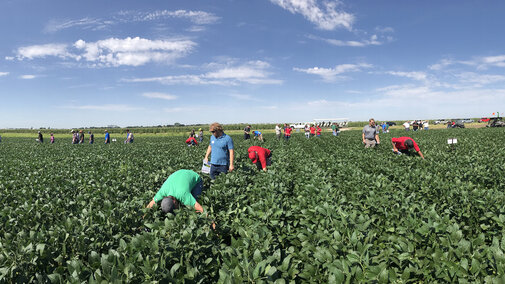Background
Is Nitrogen (N) Limiting High Soybean Yield?
Based on surveys conducted during seven teaching sessions in 2019 and 2020, 40% of the attendees representing 137,000 acres of irrigated soybean production in western Nebraska reported to chemigate some level of N fertilizer during the soybean reproductive stages (25-50 lbs N /ac most common rate). The main reasons for adopting this practice are based on the notion that biological fixation and residual soil N are often not able to meet N demand of high-yielding soybean (≥70 bu/ac).
Mortzinis et al. (2017) reported a minimal effect of N on soybean yield (0-2 bu/ac increase) in 207 environments (site-years) across the 16 land-grant universities. There are a few studies from eastern parts of Nebraska (Cafaro La Menza et al. 2018, Wortmann et al. 2012) and Kansas (Wesley et al. 2014), where researchers quantified yield responses to fertilizer N sufficient to justify the additional expense associated with the application. In one study, the application of 27 lb/ac N at R3 increased an average yield by 1.1. bu/ac across 44 locations with > 60 bu/ac yield, while no additional yield increase was observed with the application of 54 lbs of N/ac. Variability in yield response to N can depend on differences in soybean cultivars, soil properties, weather conditions and agronomic practices (Mortzinis et al. 2017).
| Trt | Fertility Treatment | Application Time | Application Method | Products and Rates Used |
|---|---|---|---|---|
| 1 | Control - Inoculant | Planting | Seed treatment | Inoculant - Verdesian @ 2x rate |
| 2 |
Control - High N |
Pre-plant Planting |
broadcast seed treatment |
Urea (46-0-0) @ 869 lbs /ac (400 lbs of N/ac) Inoculant - Verdesian @ 2x rate |
| 3 |
Chicken manure broadcast |
Pre-plant Planting |
broadcast seed treatment |
Beju chicken manure (pelleted) @ 12 ton/ac Inoculant - Verdesian @ 2x rate |
| 4 |
Cow manure broadcast |
Pre-plant Planting |
broadcast seed treatment |
Beju cow manure (pelleted) @ 12 ton/ac Inoculant - Verdesian @ 2x rate |
| 5 |
Chicken manure in-furrow |
Planting |
seed treatment insecticide box |
Inoculant - Verdesian @ 2x rate Beju chicken manure (powdered) @ 25 lba/ac |
| 6 |
Cow manure in-furrow |
Planting |
seed treatment insecticide box |
Inoculant - Verdesian @ 2x rate Beju cow manure (powdered) @ 25 lba/ac |
| 7 |
Mg High Rate |
Pre-plant Planting |
broadcast seed treatment |
MgSO4 @ 750 lbs/ac (270 lbs Mg/ac) Inoculant - Verdesian @ 2x rate |
| 8 |
Mg Low Rate |
Pre-plant Planting |
broadcast seed treatment |
MgSO4 @ 388 lbs/ac (140 lbs Mg/ac) Inoculant - Verdesian @ 2x rate |
| 9 |
Aurora Starter + Foliar |
Planting Planting V3 V6 R2 R5 |
seed treatment seed treatment foliar foliar foliar foliar |
Inoculant - Verdesian @ 2x rate Hustle @ 1 gal/ac Heighten @ 8 oz/ac (no product label) + Realize @ 2 oz/ac Heighten @ 8 oz/ac (no product label) + Realize @ 2 oz/ac Realize @ 4 oz/ac + N-cline @ 1 gal/ac + Evito @ 2 oz/ac Boron + Molybdenum (no product label) @ 1 qt/ac |
| 10 |
Nutrien 1 Starter only |
Pre-plant Planting |
broadcast seed treatment |
Micro Starter @ 0.3 gal/ac (no product label) Inoculant - Verdesian @ 2x rate |
| 11 |
Nutrien 2 Starter + Foliar |
Pre-plant Planting R2 |
broadcast seed treatment foliar |
Micro Starter @ 0.3 gal/ac (no product label) Inoculant - Verdesian @ 2x rate NutriSyncD @ 10 oz/ac |
| 12 |
Kugler Foliar products |
Planting V2 V3 R2 R5 |
seed treatment foliar foliar foliar foliar |
Inoculant - Verdesian @ 2x rate KS178c @ 1 gal/ac + LS624 @ 1 gal/ac + FA20 @ 1 gal/ac KS2075 @ 1.5 gal/ac + LS624 @ 0.5 gal/ac + FA20 @ 1 pt/ac KS2075 @ 2 gal/ac + FA20 @ 1 pt/ac KS2075 @ 1 gal/ac + LS624 @ 1 gal/ac + FA20 @ 1 pt/ac |
Soybean Response to Late-season N in Western Nebraska
In 2017, on-farm research studies were conducted in three southwest counties (Perkins, Chase and Lincoln) with no increase in soybean yield or grain protein with 80 lbs of N/ac at R3 (beginning pod). In addition, low efficiency in fertilizer N utilization (~13%) was observed, with the only notable difference being a 5-14 lbs of N/ac increase in crop residue. The study protocol was changed in 2018 to chemigate less fertilizer (50 lbs of N/ac) at later growth stages (R5-beginning seed) growth stages, and that did not change the outcomes. Leaf tissue analysis in all studies tested low on magnesium (Mg). At the same time, N and all other macronutrients and micronutrients remained within the sufficiency range for most of the soybean growing season.
Table 2. Yield (bu/ac), grain protein (%), grain oil for 12 soybean fertility treatments evaluated during 2019 and 2020 growing season at Grant, Nebraska.| Trt # | Treatment name | 2019 | 2020 | |||||
|---|---|---|---|---|---|---|---|---|
| Yield (bu/ac) | Grain protein (%) | Grain oil (%) | Yield (bu/ac) | Grain protein (%) | Grain oil (%) | |||
| 1 | Control - Inoculant | 77 | 35.7 | 21.1 | 76 | 37.7 | 19.1 | |
| 2 | Control - High N | 74 | 35.7 | 21 | 67 | 38.4 | 19 | |
| 3 | Chicken manure - broadcast | 78 | 34.9 | 20.8 | 74 | 37.1 | 18.7 | |
| 4 | Cow manure - broadcast | 73 | 35.5 | 20.9 | 79 | 37.4 | 19.2 | |
| 5 | Chicken manure - in furrow | 74 | 35.5 | 21 | 73 | 38.2 | 19.1 | |
| 6 | Cow manure - in furrow | 76 | 35.3 | 21.4 | 74 | 38.1 | 19.1 | |
| 7 | Mg - High rate | 78 | 35.3 | 20.9 | 74 | 37.8 | 19.4 | |
| 8 | Mg - Low rate | 78 | 35.7 | 20.7 | 74 | 37.8 | 19 | |
| 9 | Aurora - Starter + Foliar | 74 | 34.5 | 20.6 | 73 | 37.6 | 19.1 | |
| 10 | Nutrien 1 - Starter only | 77 | 36 | 20.9 | 70 | 38 | 19.3 | |
| 11 | Nutrien 2 - Starter + Foliar | 76 | 36 | 21 | 72 | 38.1 | 20 | |
| 12 | Kugler - Foliar products | 76 | 35.5 | 21 | 69 | 37.6 | 19.4 | |
| Average of all treatments | 75.9 | 35.4 | 20.9 | 73 | 37.8 | 19.2 | ||
| Difference for significance at 5% | 12 | 1.4 | 0.94 | 8 | 0.7 | 1.3 | ||
| Coefficient of variation (CV) | 11 | 2.5 | 2.83 | 7 | 1.1 | 4.2 | ||
Will Compost and Other Biological Products Work?
When Jimmy Frederick from Rulo, Nebraska (eastern Nebraska) raised 138 bu/ac soybeans to win 2017 state and national dryland soybean yield competition, many farmers wanted to learn from his approach. Frederick did not apply any synthetic fertilizer N and based his entire fertility program on biological products. In our 2018 fertility study in western Nebraska, early planted soybeans in 15-inch rows benefited from pre-plant application of compost at 5 ton/ac, yielding as much as 107 bu/ac (the result of one site-year). Such an outcome initiated a need to repeat the study and look more into the other fertility treatments that might increase soybean yield.
Soybean Fertility Study in 2019 and 2020
The study was conducted at Henry J. Stumpf International Wheat Center near Grant, Nebraska in 2019 and 2020. In both years, soybean was planted at 30-inch row spacing in early May. Soybean variety GH2499X (Golden Harvest 2.4 maturity) was used in 2019 and AG27X98 (Asgrow Xtend, 2.7 maturity) in 2020.
Total of 12 fertility programs were compared, including inoculant only, high N control (400 lbs of N/ac), cow and chicken manure applied both broadcast and in-furrow, two levels of Mg fertilizer, and four programs based on seed and foliar treatments recommended by our local fertilizer suppliers (Table 1).
Experimental treatments were replicated three times, with individual plots being 20-foot wide by 60-foot long in 2019 and 10-foot wide by 100-foot long in 2020. The following data was collected in each experimental plot: bi-weekly soil and tissue samples, yield, grain quality (protein and oil), and yield components (plants/acre, nodes/plant, branches/plant, pods/plant, seed weight).
The main objective was to identify the nutrients that limit high soybean yield and grain protein.
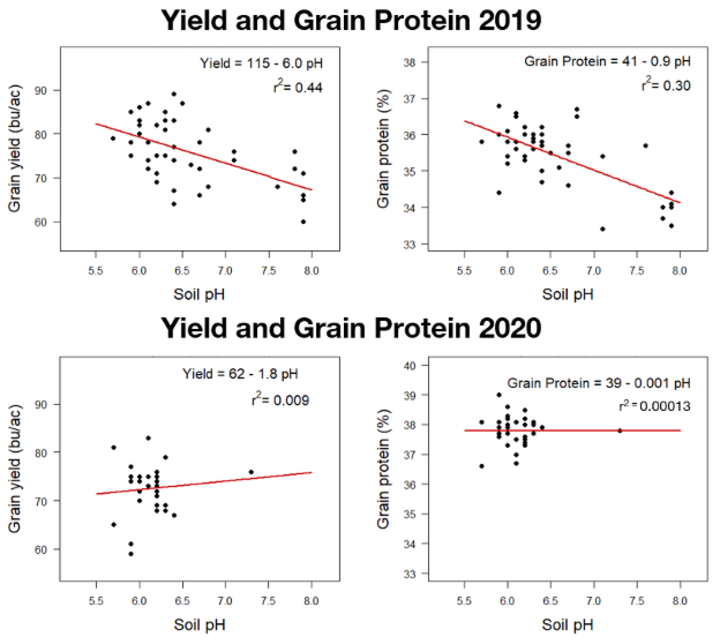
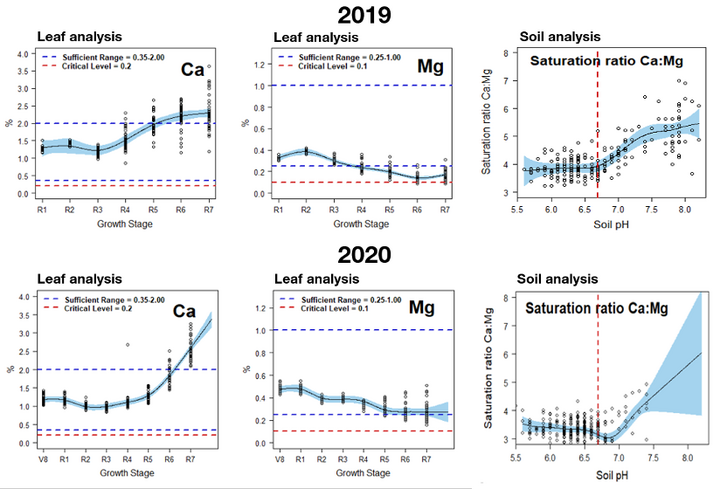
Key Takeaways from the Study
1. Fertility treatments had no impact on soybean. Fertility treatments had minor to no impact on soybean yield, grain protein, seed oil content in both 2019 and 2020 (Table 2). Although broadcasted chicken manure had slightly elevated levels of micro and macro nutrients in 2020 soil and tissue samples, this led to no significant yield increase.
Irrigated Soybean Guide
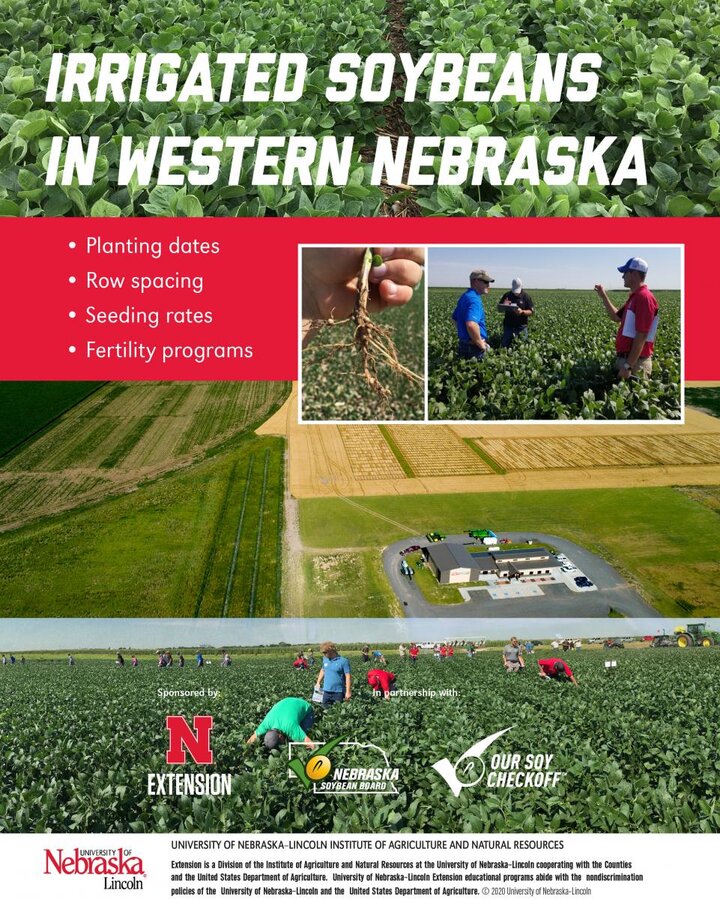
2. N supply was not a yield-limiting factor. Multiple evidence suggest that N supply was sufficient: (1) N levels in tissue samples did not reach the critical level at any point during the growing season, except at crop maturity-R8 (Figure 3 and 4); (2) The High N control, the treatment designed to provide sufficient N supply throughout the growing season, had significantly higher end-of-season residual soil N than any other fertility treatment (N demand did not exceed supply); (3) Yield and grain protein did not differ by fertility treatments (Table 2).
3. Soil pH was the main factor limiting soybean yield and grain protein. Despite the relatively flat topography, uniform soil type, similar soil organic matter (OM), and cation exchange capacity across the study area, soil pH varied significantly from plot to plot. In 2019, 10 bu/ac reduction in yield and 1.5% reduction in grain protein was observed when soil pH > 7.5 (Figure 1). In 2020, soil pH levels throughout the study area were in the optimal level for soybean growth and development (5.6 to 7.3), thus had no impact of soil pH on soybean yield and protein (Figure 1).
4. Magnesium (Mg) deficiency. Magnesium levels in tissue samples were at the lower end of sufficiency range in the early reproductive (R1-R3) and were approaching the critical level during late reproductive stages (R3-R7; Figure 2). The decrease in Mg levels at late reproductive stages (R3-R4) coincided with the sharp increase of Ca concentration in the soybean tissue, suggesting a plausible inhibitory (i.e. unlikely preferential) uptake of Ca over Mg (Figure 2). As soil pH increased, Ca concentration in soil solution increased disproportionally compared to Mg, causing a sharp increase in Ca:Mg saturation ratio (and K:Mg), especially at soil pH levels > 6.7 (Figure 2). We hypothesize that Mg uptake in soybean, especially in late reproductive stages, may be hindered due to soil replenishing with a disproportional amount of Ca into the soil solution.
5. Molybdenum (Mo) levels low at late reproductive stages. Molybdenum levels in soybean tissue were at the lower end of sufficiency range during the seed filling period (Figure 5 and 6). Molybdenum plays an important role in soybean N-fixation, and increasing its availability to the plant at late reproductive stages may help soybean maintain high rates of N-fixation. All other micronutrients were within the sufficiency range throughout the growing season (Figure 5 and 6).
Recommendations
The results of this study validate the current UNL fertilizer recommendations for soybean, especially when it comes to avoiding the routine application of N fertilizer. Soil tests cannot predict the need for N fertilizer; therefore, an in-season tissue sampling as well as inspecting root nodule number, spread and activity are advised before making such a decision. Soybean response to N is, however, more likely to occur in high-yielding environments (> 80 bu/ac) and in certain conditions such as soil pH Wortmann et al. 2018). When it comes to applications of compost, manure and other specialty products (micronutrients, foliar products, etc.), more research is needed to identify specific environmental conditions and soybean varieties where those applications might be warranted.
Soil pH was found to be the main factor influencing soybean yield and grain protein content. Significant decline in soybean yield and grain protein was observed at pH > 7.5., which is outside the optimal soil pH range (5.5-7.0) for soybean nutrient uptake and biological N-fixation. Recent advances in on-the-go field mapping for various soil properties and areal/satellite imagery can help farmers identify areas of the field with high soil pH and treat them as site-specific zones. Improving soybean management when soil is calcareous with pH > 7.5, especially if symptoms of lime-induced chlorosis have been previously observed, may include: careful use of herbicides, planting iron-deficiency tolerant varieties at higher seeding rates in 30-inch rows, avoiding high soil nitrate levels and applying chelated-iron products in the seed furrow at planting.
Tissue analysis in the past few years has consistently showed low/critical levels of magnesium both in our soybean research studies and on-farm samples. Soil analysis, however, always indicated an adequate supply of Mg and a range of Ca:Mg saturation ratio that is considered optimal for soybean production. Significant amounts of Mg are applied in irrigation water. Furthermore, we observed no yield increase (or increase in levels of Mg in tissue) with the application of 140 and 270 lbs of Mg/ac approximately 30 lbs of Mg/ac was applied through the irrigation water. Although it appears that Mg uptake is somewhat hindered by large amounts of Ca, soybeans had no yield response to applied Mg fertilizer in western Nebraska.
Appendix:


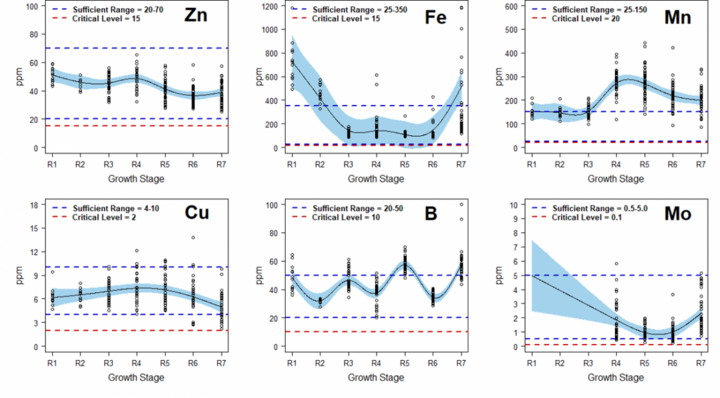
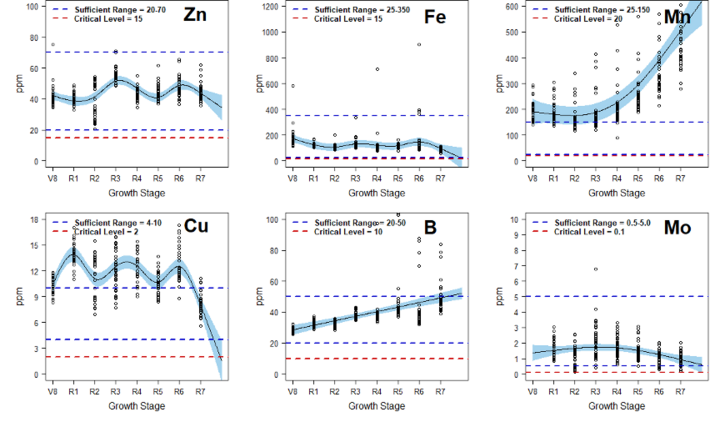
References
Cafaro La Menza N, Monzon JP, Specht JE, Grassini P. 2017. Is soybean yield limited by nitrogen supply?. Field Crops Res. 213, 204-212.
Balboa G. R., D.R. Hodgins, I.A. Ciampitti. 2015. Late-Season Nitrogen Fertilizer Application in Soybean. Kansas Agricultural Experiment Station Research Reports: Vol. 1: Iss. 2. https://doi.org/10.4148/2378-5977.1016, link: https://newprairiepress.org/cgi/viewcontent.cgi?article=1016&context=kaesrr
Cafaro La Menza N., P. J. Specht, J. Rees, A. Timmerman, T. Whitney, and K. Glewen. 2018. Is Soybean Yield Limited by Nitrogen Supply? Nebraska Extension Crop Watch (January 8, 2018), link: https://cropwatch.unl.edu/2018/soybean-yield-limited-nitrogen-supply
Grassini P., J. Rees N. Cafaro La Menza, and J. Specht. 2016. What does it take to produce 80+ bu/ac soybean? (EC 3000) UNL Extension Circular, link: http://extensionpublications.unl.edu/assets/pdf/ec3000.pdf
Jimmy Frederick Booms 163 Bu. 2017. AgWeb Farm Journal (Feb 27, 2018), link: https://www.agweb.com/news/crops/crop-production-news/crops/planting/jimmy-frederick-booms-163-bu-soybeans
Mortzinis S., G. Kaur, J. Orlowski, C. Shapiro, C. Lee, C. Wortmann, D. Holshouser, E. Nafziger, H. Kandel, J. Niekamp, J. Ross, J. Lofton, J. Vonk, K. Roozeboom, K. Thelen, L. Lindsey, M. Staton, S. Naeve, S. Casteel, W. Wiebold, and S. Conley. 2017. Soybean response to nitrogen application across the United States: a synthesis-analysis. Field Crops Res. 215:74-82. doi.org/10.1016/j.fcr.2017.09.035
Stepanovic S. N. Arsenijevic, Z. Ugljic. 2018a. Is Late Season N Fertilization Warranted for Irrigated Soybean in Western Nebraska? Nebraska Extension Crop Watch (November 2, 2018), link https://cropwatch.unl.edu/2018/late-season-n-soybeans
Stepanovic S., N. Arsenijevic, Z. Ugljic. 2018b. Seeding Practices and Nitrogen Management for Western Nebraska Soybean: What Matters and Why. Nebraska Extension Crop Watch (December 18, 2018), link: https://cropwatch.unl.edu/2018/soybean-seeding-N-mgmt-western-NE
Wesley, R. E. Lamond, V. L. Martin and S. R. Duncan. 2013. Effects of Late-Season Nitrogen Fertilizer on Irrigated Soybean Yield and Composition. J. Prod. Agric., Vol. 11 No. 3, p. 331-336 https://newprairiepress.org/cgi/viewcontent.cgi?article=1016&context=kaesrr
Wortmann, C.S., B.T. Krienke, R.B. Ferguson, B. Maharjan. 2018. Fertilizer recommendations for soybean. G859, revised, link: http://extensionpublications.unl.edu/assets/pdf/g859.pdf
Wortmann, C.S., C.A. Shapiro, R. Ferguson, and M. Mainz. 2012. Irrigated soybean has a small response to nitrogen applied during early reproductive growth. J. Crop Manage.
Balboa G. R., D.R. Hodgins, I.A. Ciampitti. 2015. Late-Season Nitrogen Fertilizer Application in Soybean. Kansas Agricultural Experiment Station Research Reports: Vol. 1: Iss. 2. https://doi.org/10.4148/2378-5977.1016, link: https://newprairiepress.org/cgi/viewcontent.cgi?article=1016&context=kaesrr
